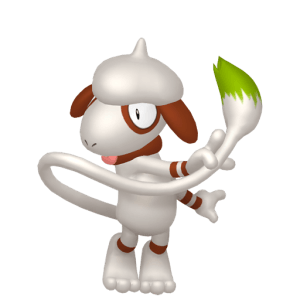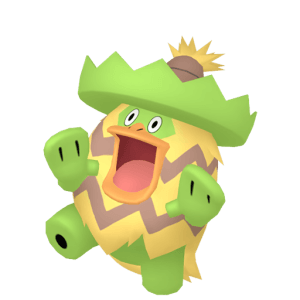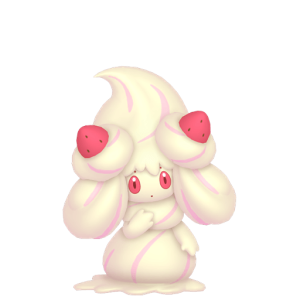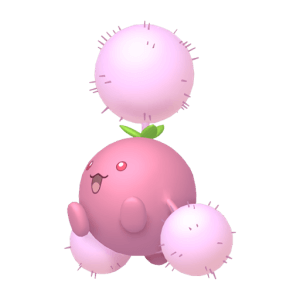In this recurring series, I’ll analyze the origins of Pokémon designs, their culture, and their historical allusions to British culture.
The three starter Pokémon take their inspiration from contemporary British culture. In the case of Grookey, it is inspired by the British pop genre.
Grookey
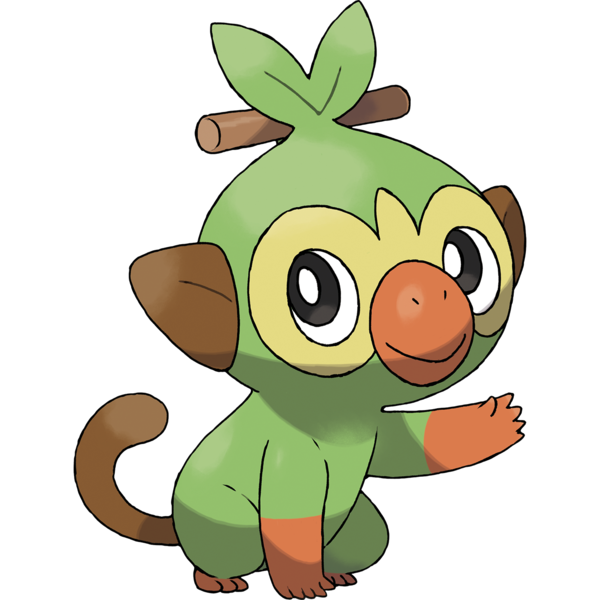
Grookey’s name is a combination of “groove” and “monkey”. Groovy is derived from the word groove with a particular musical connotation. The word originated from jazz in the 1920s which referred to the groove or “feel” of a particular rhythm. At the time, music was also played on record players, where a needle would run through grooves in the record that corresponded to what should be played.
While jazz originated in African-American communities in the United States and the rhythmic styles were adopted by many American bands, its influence made its way to the United Kingdom following World War II. As American soldiers were stationed around the nation, they brought and shared culture with the local people.
In cities like Liverpool, young Britains who listened to this music wanted to recreate it. This led to a number of rock & roll bands like The Beatles. Around the same time, an American rock band called The Monkees was formed.
This evolutionary line seems to pay homage to the musical culture that formed in 1960s England, right at the time that the word “groovy” was created to describe the music.
In particular, these Pokémon are based on the drummer of the band. They use drumsticks to create percussive noises. In rock bands they would typically use a drum kit which provides easy access to a number of percussive noises like drums and cymbals. For Grookey, it doesn’t have any instruments and instead bangs on the ground. According to its Pokédex entries:
When it uses its special stick to strike up a beat, the sound waves produced carry revitalizing energy to the plants and flowers in the area.
It attacks with rapid beats of its stick. As it strikes with amazing speed, it gets more and more pumped.
The percussive energy that Grookey uses turns into natural energy that is absorbed by plants and grass, leading to its Grass typing.
Grookey’s design seems to be based on a squirrel monkey, a monkey found in tropical forests of Central and South America. It shares the same facial features like the light fur around the eyes and a darker coloring around its mouth. They both also have orange fur on their forearms.
Thwackey
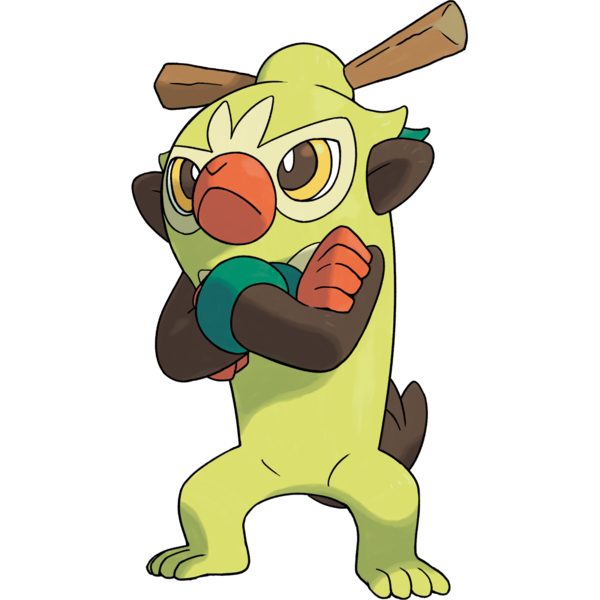
Grookey evolves into Thwackey, becoming bipedal. Its single branch has now turned into two drumsticks. Its name seems to be a combination of “thwack” and “monkey”.
It is said to drum quickly and get immersed in the music according to the Pokédex entries:
The faster a Thwackey can beat out a rhythm with its two sticks, the more respect it wins from its peers.
When it’s drumming out rapid beats in battle, it gets so caught up in the rhythm that it won’t even notice that it’s already knocked out its opponent.
Again its design may come from squirrel monkeys, but it could also be based around the Barbary macaques, a monkey species that lives on the British territory of Gibraltar. It’s the only species of monkey that lives in the wild in Europe.
If it is based around macaques monkeys, it could be another source of inspiration for the choice of a monkey. A paper published through the National Institute of Health explored how monkeys created repeated and regular percussive noises, like a drumbeat. This behavior could be used as a form of communication.
Rillaboom
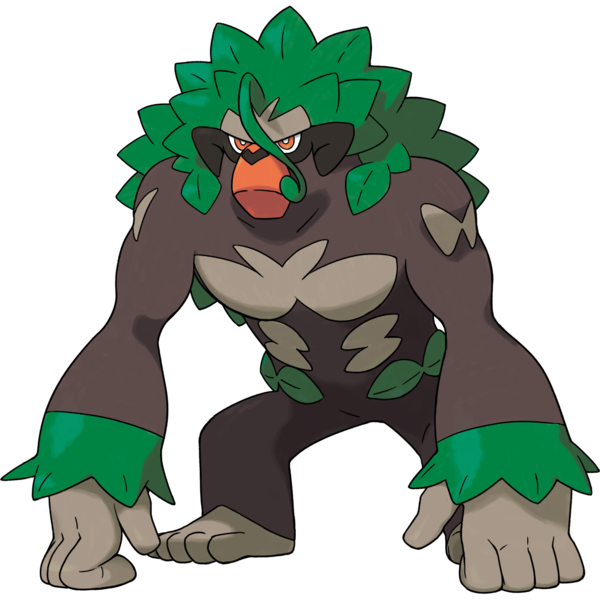
Thwackey evolves into a much larger and tougher Pokémon. It develops a long head of hair made of leaves and much larger arms. The tail it had previously disappears, and this change in its center of gravity may be the reason why it leans forward.
Its name is a combination of “gorilla” and “boom”, indicating its design is now inspired by gorillas. There is an internationally famous British band from the late 1990s called Gorillaz, but whether or not a region based on the UK having a gorilla-like starter because of it is debatable.
It now has a drum that it carries around to use its signature move Drum Beating. The drum appears to be made out of a tree stump based on its Pokédex entries:
By drumming, it taps into the power of its special tree stump. The roots of the stump follow its direction in battle.
The one with the best drumming techniques becomes the boss of the troop. It has a gentle disposition and values harmony among its group.
In rock, this drum may be a bass drum due to its larger size and the larger drum sticks. However, one wouldn’t use a drumstick on a bass drum due to the risk of breaking it. Instead, this could be a taiko drum, a Japanese drum that produces a deep thud similar to a bass drum.
Gigantamax Rillaboom

In the Isle of Armor DLC, Rillaboom receives a Gigantamax form that takes its drumming to the next level. Its long hair now branches out and holds drum sticks in order to play on its large drum kit. The drum kit seems to have snare drums, a bass drum, and cymbals all made out of different types of wood.
The Pokédex website provides this information:
Rillaboom’s tree-stump drum has grown rapidly—to the point that it now resembles a small forest on its own. Gigantamax Rillaboom has merged with this forest of drums and become even more powerful. It can control its sticks as if they were its own limbs, and it will demonstrate transcendental drumming techniques.
Gigantamax Rillaboom will focus completely on playing its drums, compelled by the power welling up inside it. The sound can reach across oceans and be heard by those living in other regions. It’s said that those who hear the beat will begin to dance uncontrollably, overwhelmed by a rhythm that surges up from inside them.
– Official Site
Humans hear only a subset of all the sounds in the world, only those at a frequency between 20 Hz to 20 KHz. Below that frequency is infrasound. Infrasound is able to travel very far in mediums including air and sound. Many animals are able to use it to communicate for hundreds of miles.
It is very likely that Gigantamax Rillaboom does produce infrasound music. With an introduction to drums and frequencies, you see that even human-sized tom and snare drums produce sounds around 100 Hz. It is possible to adjust the frequency slightly by tightening or loosing the head of the drum. The tighter it is, the higher the pitch. Of course, larger drums are naturally going to produce lower frequencies. At the size of Gigantamax Rillaboom (about 91 feet), it would be highly unlikely that the sound produced for any percussive element is greater than 20 Hz.
While we may not be able to hear it, we can often feel loud bass sounds by changes in sound pressure. The Pokédex entry may suggest we can still feel the strong beating of the drums even if we cannot physically hear.
Conclusion
To conclude, British rock has been a large part of their culture for over half a century. Since the start of bands like The Beatles, the rhythmic tunes and catchy melodies have spread throughout the world and inspired many others to form their own musical groups.
Grookey, Thwackey, and Rillaboom pay homage to this cultural history. Their monkey and gorilla designs are based around real percussive rhythms that the animals make, and they stay true to the design all the way to the Gigantamax form.
If you’re missing Grookey from your collection or want to try out the awesome power of Rillaboom in battle, why not hop in our Discord server and find people to play with?



